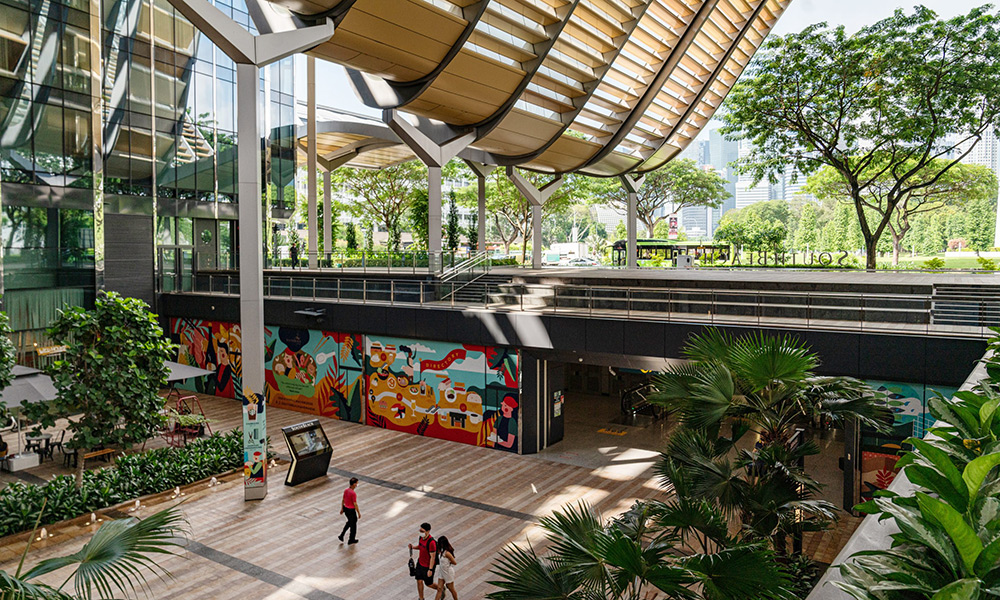
亞洲正處于氣候危機第一線,。在受洪水和極端天氣威脅最嚴(yán)重的15個國家中,有10個位于亞洲,。這就是為什么在談到亞洲房地產(chǎn)和氣候變化時,,我們經(jīng)常談到彈性。如何保護(hù)建筑物免受不斷上漲的海水,、破壞性極強的風(fēng)暴乃至高溫的影響,?
但我們可能忽略了將建筑本身當(dāng)成問題的根源。每年40%的碳排放來自房地產(chǎn),,即使對了解可持續(xù)性的人們來說,,這一數(shù)字也讓人瞠目。
建筑在改變氣候方面的巨大作用應(yīng)該敲響警鐘,。負(fù)責(zé)建造,、經(jīng)營和維護(hù)建筑的房地產(chǎn)公司如果想減少對氣候的影響,能發(fā)揮什么作用?
對商界領(lǐng)袖和全球決策者來說,,聯(lián)合國政府間氣候變化專門委員會(Intergovernmental Panel on Climate Change)的報告敲響一記警鐘,報告中強調(diào)了建筑和經(jīng)營產(chǎn)生的碳排放,。建筑過程中以及用于加熱,、冷卻和照明建筑物的能源都會產(chǎn)生碳排放。隨著全球建筑存量翻一番,,從現(xiàn)在到2050年,,建筑材料本身的碳排放量將占房地產(chǎn)碳足跡總量的近一半。
渴望改變
企業(yè)和公眾利益團(tuán)體越發(fā)關(guān)注房地產(chǎn)投資組合對環(huán)境的影響,。事實上,,有數(shù)據(jù)顯示,83%的房地產(chǎn)使用者和78%的投資者接受了氣候造成金融風(fēng)險的概念,。
在政府間氣候變化專門委員會的報告發(fā)布后,,全球各地對可持續(xù)性的審查不斷加強,促使執(zhí)行計劃不夠積極的公司推進(jìn)變革,。五分之一的企業(yè)所有者在可持續(xù)發(fā)展曲線上遙遙領(lǐng)先,。最終,這些領(lǐng)導(dǎo)者將推動可持續(xù)發(fā)展議程,,而其他人則要迎頭趕上,。
由于擔(dān)心氣候變化造成的金融風(fēng)險,投資者也對企業(yè)達(dá)到新道德標(biāo)準(zhǔn)施加壓力,,到2025年,,亞太地區(qū)實現(xiàn)凈零碳承諾的公司數(shù)量將增加一倍。連普通員工也在推動趨勢,,70%的受訪員工認(rèn)為,,可持續(xù)發(fā)展計劃是當(dāng)今企業(yè)必須選擇的道路。
然而,,如果不重點關(guān)注建筑環(huán)境,,企業(yè)乃至國家對凈零排放的承諾就無法真正實現(xiàn)。以可持續(xù)方式改造建筑也能夠為業(yè)主,、投資者和使用者直接創(chuàng)造價值,。
價值增加可能來自不太受關(guān)注的地方。我們發(fā)現(xiàn),,80%的員工希望在有植物和戶外空間的建筑物,,比如有屋頂花園的大樓中工作。因此,,支持可持續(xù)性的努力將在員工效率和留任率方面產(chǎn)生回報,。
找出變革的障礙
如果企業(yè)在可持續(xù)性方面處于領(lǐng)先地位,最終將為綠色投資、租賃和運營制定標(biāo)準(zhǔn),,其他方面只能遵循標(biāo)準(zhǔn),。然而當(dāng)前只有五分之一的企業(yè)有明確的可持續(xù)發(fā)展目標(biāo),脫碳是房地產(chǎn)戰(zhàn)略的關(guān)鍵,。
很多企業(yè)向可持續(xù)發(fā)展邁進(jìn)面臨內(nèi)部障礙,,例如管理層脫節(jié)、可持續(xù)發(fā)展戰(zhàn)略與當(dāng)前業(yè)務(wù)目標(biāo)錯位,、面對緊迫的企業(yè)需求而放棄優(yōu)先向可持續(xù)發(fā)展投資,,以及缺乏利益相關(guān)方問責(zé)制等等。
企業(yè)面臨的外部障礙可能更難解決,,比如受基礎(chǔ)設(shè)施老化局限,,或者無法獲得智能建筑和能源監(jiān)測等最新技術(shù)和數(shù)據(jù)。
實施各項措施需要企業(yè),、業(yè)主,、投資者和政府之間密切公私合作。幸運的是,,合作方式得到了強有力支持,。90%的使用者認(rèn)同,城市,、投資者,、開發(fā)商和使用者之間加強合作有助于實現(xiàn)建筑環(huán)境凈零排放的目標(biāo)。
推進(jìn)進(jìn)展如何,?太古地產(chǎn)(Swire Properties)提供免費能源審計,,幫助中國香港和內(nèi)地租戶了解使用模式并尋找節(jié)能機會,從而吸引租戶參與其中,。新加坡的環(huán)境激勵措施包括能源效率基金(Energy Efficiency Fund),,主要為企業(yè)提供資金以提高設(shè)施的能源效率,最高可達(dá)成本的50%,。種種舉措顯示了多方利益相關(guān)者加強合作以推動可持續(xù)行動的價值和重要性,。
但底線是:房地產(chǎn)在幫助企業(yè)實現(xiàn)可持續(xù)發(fā)展目標(biāo)方面可以且必須發(fā)揮關(guān)鍵作用。無論是在企業(yè)與員工,、業(yè)主與租戶之間,,還是在公共部門與私營部門之間,房地產(chǎn)都能夠在推動建立更可持續(xù)經(jīng)濟所需的重要關(guān)系方面發(fā)揮關(guān)鍵作用,。
當(dāng)前房地產(chǎn)既是氣候危機的原因,,也是受害方。換個角度看,,房地產(chǎn)可能也是解決問題的關(guān)鍵,。(財富中文網(wǎng))
卡米亞·米格拉尼是仲量聯(lián)行(Jones Lang LaSalle)亞太區(qū)企業(yè)解決方案研究董事。
譯者:馮豐
審校:夏林
亞洲正處于氣候危機第一線。在受洪水和極端天氣威脅最嚴(yán)重的15個國家中,,有10個位于亞洲,。這就是為什么在談到亞洲房地產(chǎn)和氣候變化時,我們經(jīng)常談到彈性,。如何保護(hù)建筑物免受不斷上漲的海水,、破壞性極強的風(fēng)暴乃至高溫的影響?
但我們可能忽略了將建筑本身當(dāng)成問題的根源,。每年40%的碳排放來自房地產(chǎn),即使對了解可持續(xù)性的人們來說,,這一數(shù)字也讓人瞠目,。
建筑在改變氣候方面的巨大作用應(yīng)該敲響警鐘。負(fù)責(zé)建造,、經(jīng)營和維護(hù)建筑的房地產(chǎn)公司如果想減少對氣候的影響,,能發(fā)揮什么作用?
對商界領(lǐng)袖和全球決策者來說,,聯(lián)合國政府間氣候變化專門委員會(Intergovernmental Panel on Climate Change)的報告敲響一記警鐘,,報告中強調(diào)了建筑和經(jīng)營產(chǎn)生的碳排放。建筑過程中以及用于加熱,、冷卻和照明建筑物的能源都會產(chǎn)生碳排放,。隨著全球建筑存量翻一番,從現(xiàn)在到2050年,,建筑材料本身的碳排放量將占房地產(chǎn)碳足跡總量的近一半,。
渴望改變
企業(yè)和公眾利益團(tuán)體越發(fā)關(guān)注房地產(chǎn)投資組合對環(huán)境的影響。事實上,,有數(shù)據(jù)顯示,,83%的房地產(chǎn)使用者和78%的投資者接受了氣候造成金融風(fēng)險的概念。
在政府間氣候變化專門委員會的報告發(fā)布后,,全球各地對可持續(xù)性的審查不斷加強,,促使執(zhí)行計劃不夠積極的公司推進(jìn)變革。五分之一的企業(yè)所有者在可持續(xù)發(fā)展曲線上遙遙領(lǐng)先,。最終,,這些領(lǐng)導(dǎo)者將推動可持續(xù)發(fā)展議程,而其他人則要迎頭趕上,。
由于擔(dān)心氣候變化造成的金融風(fēng)險,,投資者也對企業(yè)達(dá)到新道德標(biāo)準(zhǔn)施加壓力,到2025年,,亞太地區(qū)實現(xiàn)凈零碳承諾的公司數(shù)量將增加一倍,。連普通員工也在推動趨勢,70%的受訪員工認(rèn)為,可持續(xù)發(fā)展計劃是當(dāng)今企業(yè)必須選擇的道路,。
然而,,如果不重點關(guān)注建筑環(huán)境,企業(yè)乃至國家對凈零排放的承諾就無法真正實現(xiàn),。以可持續(xù)方式改造建筑也能夠為業(yè)主,、投資者和使用者直接創(chuàng)造價值。
價值增加可能來自不太受關(guān)注的地方,。我們發(fā)現(xiàn),,80%的員工希望在有植物和戶外空間的建筑物,比如有屋頂花園的大樓中工作,。因此,,支持可持續(xù)性的努力將在員工效率和留任率方面產(chǎn)生回報。
找出變革的障礙
如果企業(yè)在可持續(xù)性方面處于領(lǐng)先地位,,最終將為綠色投資,、租賃和運營制定標(biāo)準(zhǔn),其他方面只能遵循標(biāo)準(zhǔn),。然而當(dāng)前只有五分之一的企業(yè)有明確的可持續(xù)發(fā)展目標(biāo),,脫碳是房地產(chǎn)戰(zhàn)略的關(guān)鍵。
很多企業(yè)向可持續(xù)發(fā)展邁進(jìn)面臨內(nèi)部障礙,,例如管理層脫節(jié),、可持續(xù)發(fā)展戰(zhàn)略與當(dāng)前業(yè)務(wù)目標(biāo)錯位、面對緊迫的企業(yè)需求而放棄優(yōu)先向可持續(xù)發(fā)展投資,,以及缺乏利益相關(guān)方問責(zé)制等等,。
企業(yè)面臨的外部障礙可能更難解決,比如受基礎(chǔ)設(shè)施老化局限,,或者無法獲得智能建筑和能源監(jiān)測等最新技術(shù)和數(shù)據(jù),。
實施各項措施需要企業(yè)、業(yè)主,、投資者和政府之間密切公私合作,。幸運的是,合作方式得到了強有力支持,。90%的使用者認(rèn)同,,城市、投資者,、開發(fā)商和使用者之間加強合作有助于實現(xiàn)建筑環(huán)境凈零排放的目標(biāo),。
推進(jìn)進(jìn)展如何?太古地產(chǎn)(Swire Properties)提供免費能源審計,,幫助中國香港和內(nèi)地租戶了解使用模式并尋找節(jié)能機會,,從而吸引租戶參與其中,。新加坡的環(huán)境激勵措施包括能源效率基金(Energy Efficiency Fund),主要為企業(yè)提供資金以提高設(shè)施的能源效率,,最高可達(dá)成本的50%,。種種舉措顯示了多方利益相關(guān)者加強合作以推動可持續(xù)行動的價值和重要性。
但底線是:房地產(chǎn)在幫助企業(yè)實現(xiàn)可持續(xù)發(fā)展目標(biāo)方面可以且必須發(fā)揮關(guān)鍵作用,。無論是在企業(yè)與員工,、業(yè)主與租戶之間,還是在公共部門與私營部門之間,,房地產(chǎn)都能夠在推動建立更可持續(xù)經(jīng)濟所需的重要關(guān)系方面發(fā)揮關(guān)鍵作用,。
當(dāng)前房地產(chǎn)既是氣候危機的原因,也是受害方,。換個角度看,,房地產(chǎn)可能也是解決問題的關(guān)鍵。(財富中文網(wǎng))
卡米亞·米格拉尼是仲量聯(lián)行(Jones Lang LaSalle)亞太區(qū)企業(yè)解決方案研究董事,。
譯者:馮豐
審校:夏林
Asia is on the front line of the climate crisis: 10 of the 15 nations most at risk from flooding and extreme weather are based in Asia. That can be why, when it comes to talking about Asian real estate and climate change, we often talk about resilience. How do we protect buildings from rising waters, hugely damaging storms, or even just high temperatures?
But we can miss thinking about buildings as a cause of the problem themselves: 40% of annual carbon emissions comes from real estate which—even for those in the know about sustainability—is an eye-popping statistic.
Alarm bells should be ringing over the large role our buildings play in changing our climate. But what role can real estate companies—the ones responsible for constructing, operating, and maintaining these buildings—play in reducing that role?
The Intergovernmental Panel on Climate Change’s report was a rude awakening for business leaders and global policymakers, highlighting the carbon emissions generated by the construction and operation of buildings. Emissions are released during construction, and from the energy used to heat, cool, and light up buildings. Then you have the emissions released from making the building materials themselves—which will make up almost half of the entire carbon footprint for real estate between now and 2050 as the global building stock doubles in size.
A desire for change
Business and public stakeholders are increasingly paying attention to the environmental impact of their real estate portfolio. In fact, according to our data, 83% of real estate occupiers and 78% of investors in the survey accept that climate poses a financial risk.
Driven by heightened global scrutiny around sustainability after the IPCC report, companies that were perhaps less-than-diligent in their plans are being pushed to change. One-fifth of corporate occupiers are significantly ahead on the sustainability maturity curve—these leaders will end up driving the sustainability agenda, leaving the rest to catch up.
The number of companies in Asia-Pacific that will adopt a net-zero carbon commitment is set to double by 2025, driven by concerns over the financial risk from climate change and investor pressure to meet new ethical standards. Even employees are part of the trend: Seven in 10 workers polled believe that sustainability initiatives are a must for today’s businesses.
Yet corporate, and even national, commitments to net zero cannot be meaningfully achieved without a focus on the built environment. And, in fact, adapting buildings in sustainable ways would also create upfront value for landlords, investors, and occupiers alike.
That increased value may come from unlikely places: We found that 80% of workers want to be in buildings with plants and outdoor spaces, like rooftop gardens. Thus, efforts to bolster sustainability will have a payoff in employee productivity and retention.
Identifying barriers to change
Those that lead the way on sustainability will end up setting the standards for green investment, leasing, and operations that everyone else will end up following. Yet only one in five businesses has well-defined sustainability goals, with decarbonization as a key part of its real estate strategy.
Yet many businesses face internal barriers that impede their progress toward sustainability, such as a disengaged executive leadership, misalignment between sustainability strategy and current business objectives, deprioritized sustainability investments in the face of urgent organizational needs, and a lack of stakeholder accountability.
Businesses also face external hurdles that may be tougher to address, such as being tied to a space with aging infrastructure, or that lacks access to the newest technology and data—such as smart buildings and energy monitoring.
But implementing these measures will require close private-public collaboration between businesses, their landlords, investors, and the government. Fortunately, there’s strong support for a collaborative approach: 90% of occupiers agree that collaboration between cities, investors, developers, and occupiers will be instrumental in achieving the net-zero ambitions of the built environment.
So what are people doing now? Swire Properties is engaging tenants in Hong Kong and mainland China by offering free energy audits to help them understand their usage patterns and identify energy-saving opportunities. Singapore’s incentives for the environment include an Energy Efficiency Fund (E2F), which provides funding for businesses to improve the energy efficiency of facilities for up to 50% of the qualifying costs. These initiatives demonstrate the value and importance of multi-stakeholder collaboration to move the needle on sustainable action.
But here’s the bottom line: Real estate can and must play a critical role in helping businesses turn their sustainability ambitions into reality. They can be a key enabler in building the important relationships needed to create a more sustainable economy, whether between business and employees, owners and tenants, or between the public and private sectors.
Real estate is currently both a cause and a victim of our current climate crisis. But it can be a key part of the solution as well.
Kamya Miglani is director of research, work dynamics, APAC at Jones Lang LaSalle.






